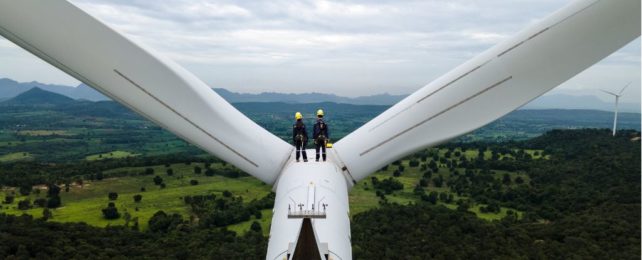Motivation to act on climate change often comes in one of two forms; the metaphorical threat of a stick or the lure of a carrot. For years now, scientists have been trying to whip our slow-moving ass into shape (to keep with the metaphor, of course).
But as we collectively drag our feet, the juicy carrot that economists are waving in front of our noses is shrinking. If we want to get our hands on it, we have to step it up.
A new study from Oxford University has shown the quicker the world transitions to clean energy, the bigger the financial bite.
If we can transition to a world of zero fossil fuels by 2050, the findings suggest the world could save up to US$15 trillion.
If instead, we take it slow, eliminating fossil fuels only by 2070, there's a greater chance the savings won't be anywhere near as lucrative.
"There is a pervasive misconception that switching to clean, green energy will be painful, costly and mean sacrifices for us all – but that's just wrong," says economist Doyne Farmer.
"Renewable costs have been trending down for decades. They are already cheaper than fossil fuels in many situations and, our research shows, they will become cheaper than fossil fuels across almost all applications in the years to come. And, if we accelerate the transition, they will become cheaper faster."
The model used in the current research forecasts the costs of deploying four types of green technology: solar energy, wind energy, batteries, and electrolyzers.
In the past, analysts have overestimated the costs of these green technologies, the authors argue. For instance, the real cost of solar energy dropped twice as fast as the most ambitious projections. The historic pessimism around renewable energy, they say, is at odds with past technological improvements, and this has locked "humanity into an expensive and dangerous energy future."
Obviously, projections are never perfect, but the models used by researchers at Oxford were statistically validated by tracing back the history of 50 different technologies.
The most successful of these technologies tend to follow an 'S-curve' for deployment. After technology takes off, there is a long phase of exponential growth in production, reducing costs. As the market becomes saturated, that growth gradually tapers off.
If clean energy takes this same path, the savings could flow once we get over the initial hill.
The new models explore three possible scenarios for that ascent, from 2021 to 2070.
The most rapid scenario, where green energy replaces up to 4 percent of fossil fuels every year, would make the 'S' shape of green energy deployment a tight curve, whereas a slower transition would drag out the deployment phase for longer than necessary.
In the 'no transition' scenario, fossil fuels would continue to dominate for most of the century.
"The primary policy implication of our results is that there are enormous advantages to rapid deployment of key green technologies," the authors write.
"Achieving this is likely to require strong international policies for building infrastructure, skills training, and making the investments required to realize future gains."
Initially, this transition will probably involve some discounts and green energy policies by governments. But luckily, these upfront costs will quickly be offset.
When future energy pathways are viewed in terms of bets placed on portfolios of technologies, the authors say the 'fast transition' scenario is expected to pay off around $5 to $15 trillion.
According to the authors, when economic damages due to climate change are taken into account the benefits become overwhelming. The fast transition scenario could reap savings of up to $255 trillion or even $755 trillion by 2070, depending on certain economic parameters.
Another big factor involves increasing scarcity in fossil fuels, inflating costs based on their use.
Wind energy and solar energy, on the other hand, are growing cheaper by the day. In fact, in dozens of nations, solar power is currently the cheapest energy on offer.
Even better, we can't run these resources dry, which means the cost of green technologies are only predicted to fall over time. Right now, they are doing so at a rate of nearly 10 percent per year.
"The combination of exponentially decreasing costs and rapid exponentially increasing deployment is different from anything observed in any other energy technologies in the past, and positions these key green technologies to challenge the dominance of fossil fuels within a decade," the authors write.
The models suggest that market forces are very much on the side of renewable energy, even if climate change wasn't the threat we now know it to be.
If agriculture and land-use change can also be brought under control, researchers think there's a chance we could actually meet the 1.5° Paris Agreement target, a goal that has become increasingly unlikely.
"In response to our opening question, 'Is there a path forward that can get us to net-zero emissions cheaply and quickly?,' our answer is: 'Very likely, and the savings are probably quite large,'" the authors conclude.
The study was published in Joule.
